The purpose of this brand guide is to make commonly used Cornell Tech brand elements easy to access, from lockups to campus messaging. Guidelines for brand use allow us to maintain consistent quality and continuity across communication channels—from the website and presentations to marketing materials—without limiting creativity.
Cornell Tech Brand Story
The language below has been created to guide you as you create content consistent with the mission and vision for the Cornell Tech campus, including the Jacobs Technion-Cornell Institute. You may want to use this language verbatim at times, or it may serve as high-level inspiration as you tell the story of the campus in presentations or other communications. A full brand narrative has been created, to frame the mission and vision of Cornell Tech.
Brand Foundations
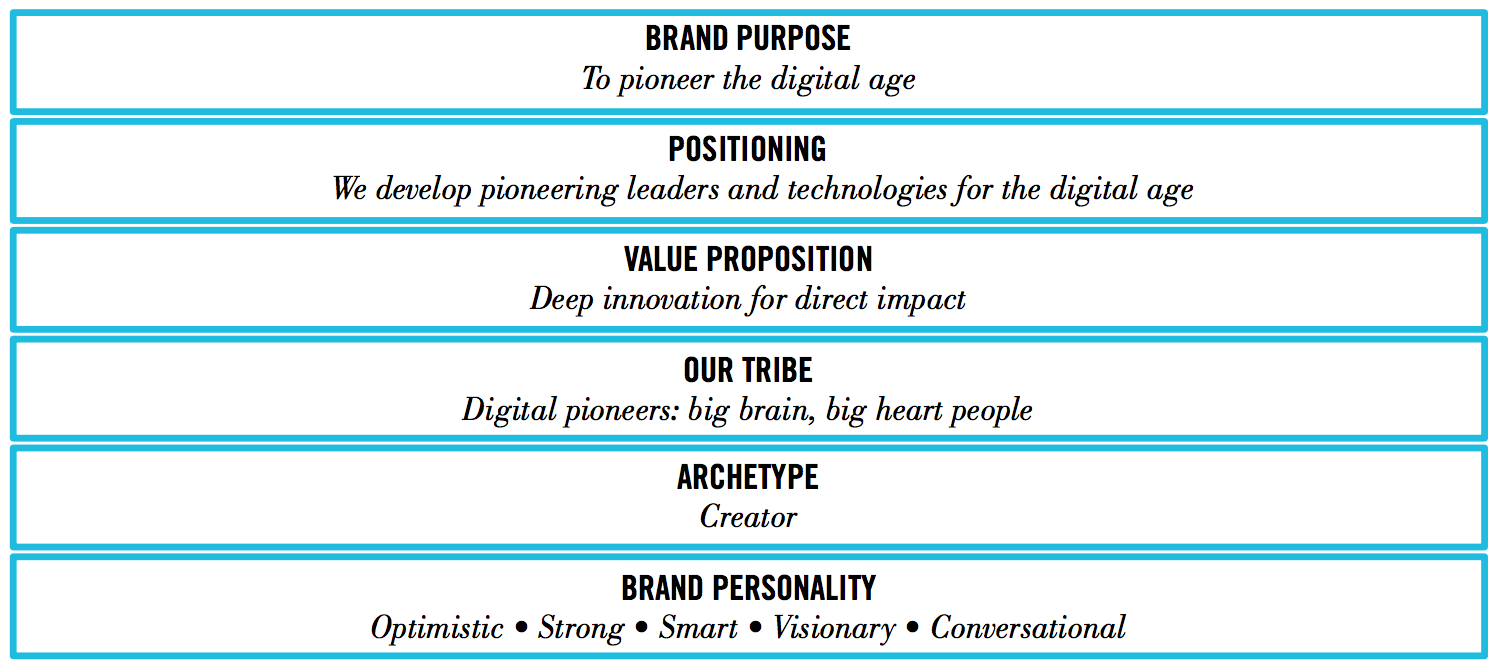
Brand Pillars

Deep Innovation
Creating foundational insights and powerful new capabilities.
Tech for Impact
Focus on real impact on the world at large.
Resolute Product Focus
Cornell Tech is not only exploring. We are putting our findings to use in the real world.
Tolerance for Chances and Risks
Designed explicitly for adaptation, change and to push the forefront of the changing digital frontier.
Drive for Action
A dogged focus on action and a disposition for innovation that makes a difference outside the campus walls.
Imbued with NYC’s Energy
Cornell Tech lives physically and daily in the hustle, energy and life-force of New York City.
Connected to the Real World
The world, its challenges and knowledge, flow through the organization to enrich the experience and inform its innovation.
Talking Points
Cornell Tech develops pioneering leaders and technologies for the digital age.
Our Talking Points are a primer on just how we are doing that—from our academic programs and initiatives to integrate industry to the status of campus construction. At times you may want to lift the copy directly, while at others it may serve as background for your own language. They are updated quarterly.
OVERVIEW
Cornell Tech brings together faculty, business leaders, tech entrepreneurs, and students in a catalytic environment to produce visionary results grounded in significant needs that will reinvent the way we live in the digital age. Cornell Tech’s temporary campus has been up and running at Google’s Chelsea building since 2012, with a growing world-class faculty, and 200 master’s and Ph.D. students who collaborate extensively with tech-oriented companies and organizations and pursue their own start-ups.
Construction is underway on Cornell Tech’s campus on Roosevelt Island, with a first phase due to open in 2017. When fully completed, the campus will include 2 million square feet of state-of-the-art buildings, over 2 acres of open space, and will be home to more than 2,000 graduate students and hundreds of faculty and staff.
Academic Model
Cornell Tech has reinvented graduate tech education for the digital age, bridging the gap between academia and industry. Our students are digital pioneers who believe in technology’s power for impact and change.
At Cornell Tech, students across programs learn and work side-by-side, spending one-third of their experience together working together on a studio-based core curriculum. They collaborate with the tech industry and postdoc-level researchers to build start-up companies and new products. By bringing these talents together at the start, there is enormous potential for better, more impactful and ultimately more successful companies and products.
Masters Degree Programs
- Master in Computer Science
- Master in Electrical and Computer Engineering
- Master in Operations Research and Information Engineering
- Technion-Cornell Dual Master’s Degrees in Connective Media
- Technion-Cornell Dual Master’s Degrees in Health Tech
- Johnson Cornell Tech MBA
- Master of Laws in Law, Technology and Entrepreneurship
Jacobs Technion-Cornell Institute
In 2011, Cornell University and the Technion-Israel Institute of Technology won the City of New York’s competition to create an Applied Sciences graduate school. The Jacobs Technion-Cornell Institute embodies the academic partnership between the Technion and Cornell University on the Cornell Tech campus.
The Jacobs Institute degree programs—Health Tech and Connective Media—focus on impacting specific NYC industries instead of traditional disciplines. In addition, recent PhD graduates are building companies at the Jacobs Institute through the Runway program, where postdocs transform their research into new companies and products.
Roosevelt Island Campus
Construction is underway on the first phase of Cornell Tech’s 12-acre campus on Roosevelt Island. Cornell has assembled a team of award-winning architects to design an open campus that will facilitate the interaction between academia and industry central to Cornell Tech’s mission. Established companies and startups, including student ventures, will be located in The Bridge, Cornell Tech’s first corporate co-location building.
The campus will be highly sustainable. The residential building will be the world’s first residential passive house high-rise, and Cornell aspires for the first academic building, The Bloomberg Center—in honor of Emma and Georgina Bloomberg—to be net zero, with all of its energy generated on campus.
Commitment to K-12
Cornell Tech has a strong commitment to enriching tech education for New York City public school children. Cornell has partnered with more than a dozen local schools, including PS/IS 217 on Roosevelt Island. We’re also hosting a series of events with Google to bring together stakeholders from City Hall, public schools and the tech industry to talk about how to prepare students for the digital age.
Diversity in Tech
Cornell Tech is committed to building and diversifying the base of the technology talent in New York City. In partnership with CUNY and Verizon, we recently launched a new program: Women in Technology and Entrepreneurship in New York (WiTNY). WiTNY will provide the access, incentives, and support needed for girls and women to succeed in the tech industry. With new computer science courses, scholarships and internships, we will expose thousands of women each year to potential careers in tech.
Brand Design Elements
Lockups, “T” Twists, Photography, Typography and Colors can be found on this page.
Lockups
Both Cornell Tech and Jacobs Technion-Cornell Institute lockups are primarily used in black or white. The components of the lockups are designed in proportion—please don’t separate the components and readjust. They can be downloaded here as .png files for most uses, as well as vector files for specific design purposes.
Cornell Tech
Cornell Tech’s preferred lockup is the vertical lockup below. For certain use cases, the Strategic Communications team may advise that one of the alternative lockups below be used.
Preferred

Alternatives

Jacobs Technion-Cornell Institute
The Jacobs Technion-Cornell Institute has both a vertical and a horizontal lockup as well. These lockups should be used when faculty, a program or event are affiliated with or hosted by the Institute.


The “T” Twist Supergraphic
The Twist or “T†– as in Technology – is at the core of our visual identity. It is a supergraphic to be used at a large scale—it shouldn’t be used small enough as to be taken for a logo. We always use it in conjunction with a vertical lockup in the proportion seen below.
Cornell Tech “T”
Cornell Tech uses the “T” as a: 1) filled “window” or; 2) a thick outline. As you can see, the vertical portion of the “T” may be cropped. You may access additional Cornell Tech supergraphic files here.
Thick Outline “T”

Filled Window “T”

Jacobs Technion-Cornell Institute “T”
The Jacobs Institute uses a wireframe version of the “T” and the bottom points should not be cropped. The Jacobs “T†is used in gray, white or PMS 286 Signal Blue. You may access additional Jacobs Technion supergraphic files here.

Photography
Cornell Tech favors a photojournalistic or candid style. AÂ library of images is maintained for faculty and staff use.
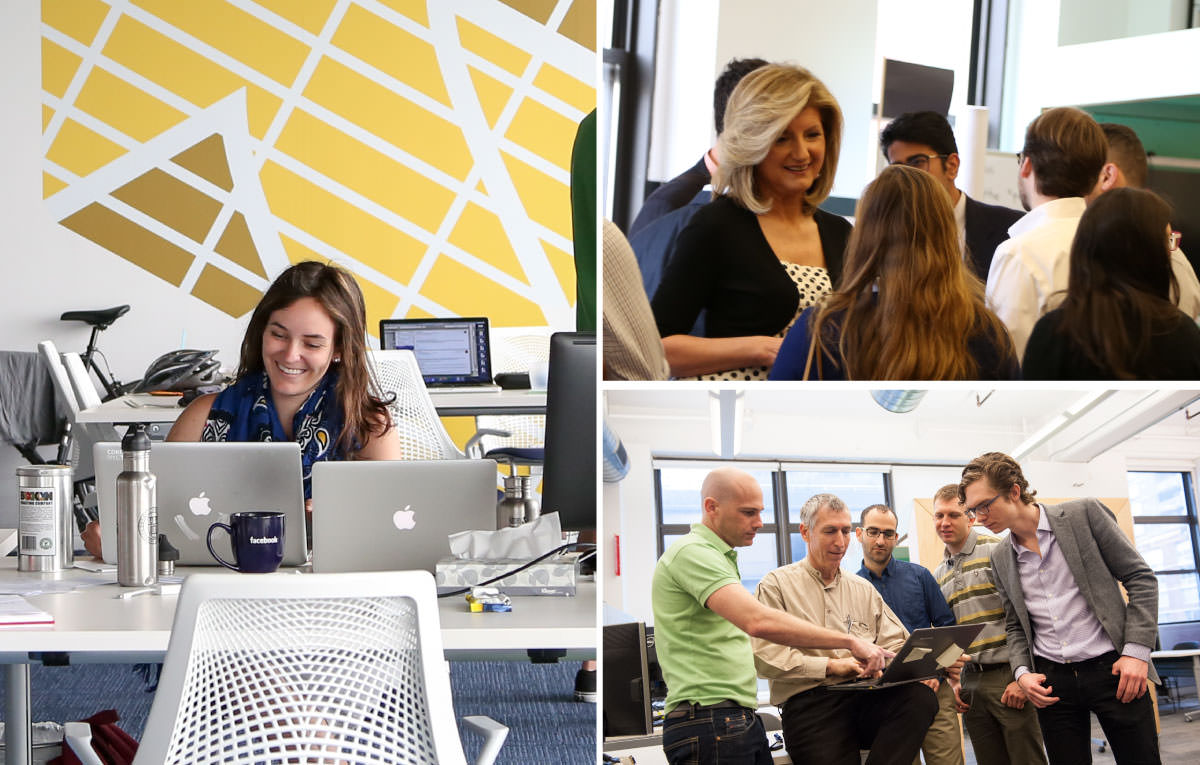
Fonts
Arial and Georgia are our system fonts to be used for general purposes like correspondence and presentations. Cornell Tech has purchased the proprietary FF Din and Adelle typefaces for our website and printed materials. We recommend that, even if you own FF Din or Adelle, that you don’t use it in presentations as the person you are sharing your work with may not, causing technical problems. If you do find you need these typefaces please contact Strategic Communications.
Proprietary Fonts

System Fonts

Cornell Tech Colors
Cornell Tech primary and secondary (or accent) colors can be found here.
Primary Color Builds

Black
C=0 M=0 Y=0 K=100
R=0 G=0 B=0
HEX= #000000
Where possible, use RICH BLACK C30 M30 Y30 K100

Primary Accent
PMS Warm Gray 7C
C=16 M=23 Y=23 K=14
PMS Warm Gray 7U
C=11 M=15 Y=18 K=37
R=150 G=140 B=131
HEX= #c0c0c0

Primary Accent
PMS Cool Gray 6C
C=16 M=11 Y=11 K=27
PMS Cool Gray 6U
C= 19 M=11 Y=11 K=28
R=167 G=168 B=170
HEX= #c8ced8

White
C=0 M=0 Y=0 K=0
R=255 G=255 B=255
HEX= #ffffff

River
PMS 294C
C=100 M=69 Y=7 K=30
PMS 294U
C=100 M=53 Y=2 K=21
R=0 G=47 B=108
HEX= #323a47

Taxi
PMS 123C
C=0 M=19 Y=89 K=0
PMS 115U
C=0 M=11 Y=94 K=0
R=255 G=199 B=44
HEX= #f3b632

Meadow
PMS 382C
C=28 M=0 Y=100 K=0
PMS 389U
C=24 M=0 Y=79 K=0
R=196 G=214 B=0
HEX= #c7d41e

Cornell Red
PMS 187 C/U
C=0 M=100 Y=79 K=20
R=170 G=20 B=45
HEX= #921c2f
Refer to brand.cornell.edu for direction on using Cornell Red.
Secondary Color Builds

Secondary Accent
PMS 295C
C=100 M=69 Y=8 K=54
PMS 303U
C=96 M=35 Y=21 K=52
R=0 G=40 B=85
HEX= #0a1e2c

Secondary Accent
PMS 1255C
C=9 M=35 Y=98 K=30
PMS 1255U
C=10 M=23 Y=93 K=24
R=173 G=132 B=31
HEX= #af841d

Secondary Accent
PMS 378C
C=47 M=11 Y=99 K=64
PMS 378U
C=36 M=11 Y=91 K=37
R=89 G=98 B=29
HEX= #59611b

Secondary Accent
PMS 188C
C=16 M=100 Y=65 K=58
PMS 188U
C=27 M=86 Y=60 K=28
R=118 G=35 B=47
HEX= #79232e

Secondary Accent
PMS 5435C
C=31 M=8 Y=6 K=11
PMS 5435U
C=32 M=9 Y=8 K=7
R=166 G=187 B=200
HEX= #a7bac8

Secondary Accent
PMS 1215C
C=0 M=6 Y=53 K=0
PMS 1215U
C=0 M=9 Y=58 K=0
R=251 G=216 B=114
HEX= #fed671

Secondary Accent
PMS 372C
C=16 M=0 Y=41 K=0
PMS 372U
C=19 M=0 Y=47 K=0
R=212 G=235 B=142
HEX= #d4eb8d

Secondary Accent
PMS 021C
C=0 M=65 Y=100 K=0
PMS 021U
C=0 M=45 Y=86 K=0
R=254 G=80 B=0
HEX= #ff5000
Jacobs Technion-Cornell Institute Colors
The Jacobs Technion-Cornell Institute uses a subsection of the Cornell Tech colors, as well as its own Signal Blue (PMS 286).

Black
C=0 M=0 Y=0 K=100
R=0 G=0 B=0
HEX= #000000
Where possible, use RICH BLACK C30 M30 Y30 K100

Primary Accent
PMS Warm Gray 7C
C=16 M=23 Y=23 K=14
PMS Warm Gray 7U
C=11 M=15 Y=18 K=37
R=150 G=140 B=131
HEX= #c0c0c0

Primary Accent
PMS Cool Gray 6C
C=16 M=11 Y=11 K=27
PMS Cool Gray 6U
C= 19 M=11 Y=11 K=28
R=167 G=168 B=170
HEX= #c8ced8

White
C=0 M=0 Y=0 K=0
R=255 G=255 B=255
HEX= #ffffff

Primary – Signal Blue
PMS 286C
C=100 M=75 Y=2 K=18
PMS 286U
C=87 M=59 Y=0 K=0
R=0 G=48 B=135
HEX= #0033a0

Accent – Taxi
PMS 123C
C=0 M=19 Y=89 K=0
PMS 115U
C=0 M=11 Y=94 K=0
R=255 G=199 B=44
HEX= #f3b632

Accent – Meadow
PMS 382C
C=28 M=0 Y=100 K=0
PMS 389U
C=24 M=0 Y=79 K=0
R=196 G=214 B=0
HEX= #c7d41e

Accent – Cornell Red
PMS 187 C/U
C=0 M=100 Y=79 K=20
R=170 G=20 B=45
HEX= #921c2f
Refer to brand.cornell.edu for direction on using Cornell Red.
Branded Templates
Branded templates for PowerPoint presentations, letterhead and envelopes as well as email signatures can be found here.
PowerPoint Templates
PowerPoint templates with both Cornell Tech and Jacobs Technion-Cornell Institute branding can be found here. In addition, slides are provided with boilerplate messaging on both Cornell Tech and the Jacobs Institute—they can be used to insert into an existing presentation or as the basis for a new one.
Cornell Tech
Simple Starter Template
To be used as the title slide of a new presentation.

Slides With Boilerplate
To be inserted into an existing presentation.
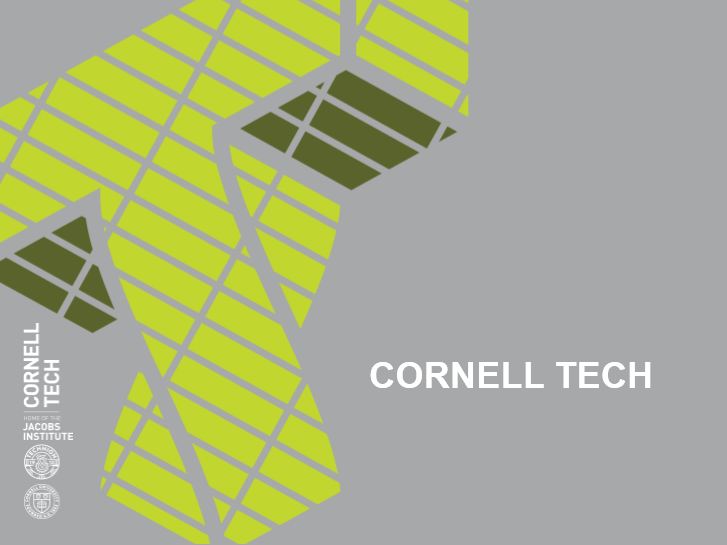
Jacobs Technion-Cornell Institute
Simple Starter Template
To be used as the title slide of a new presentation.
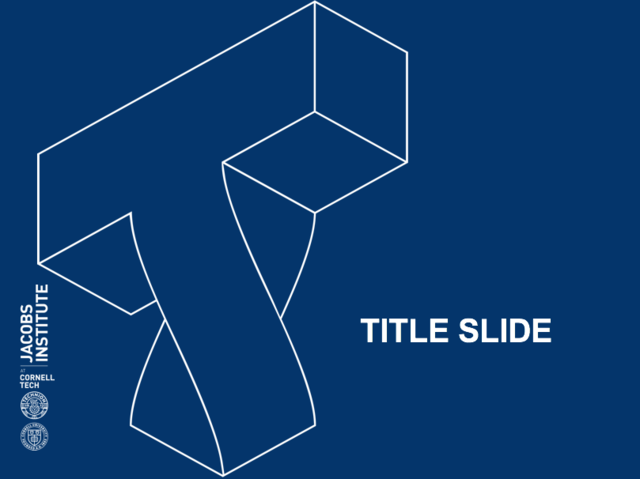
Slides With Boilerplate
To be inserted into an existing presentation.
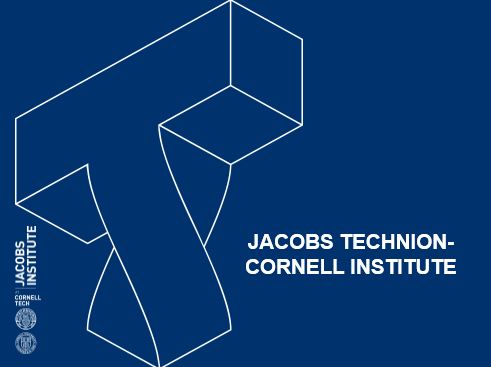
Letterhead and Envelopes
Cornell Tech
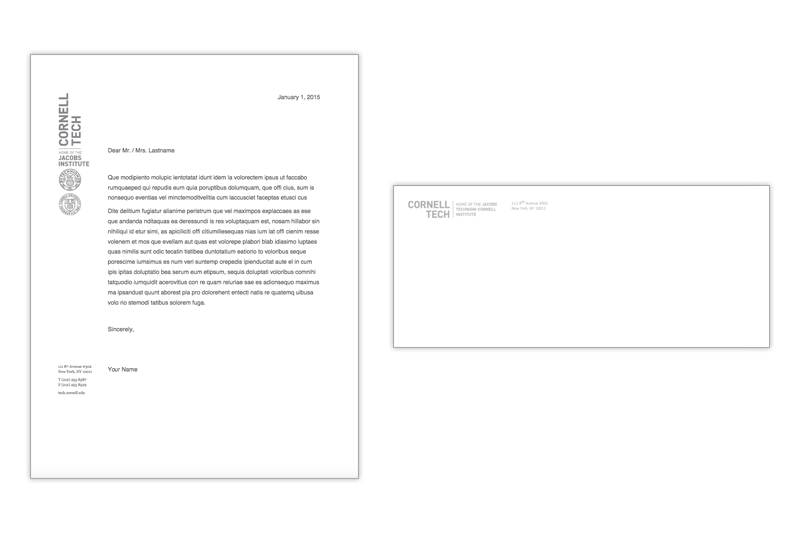
Jacobs Technion-Cornell Institute
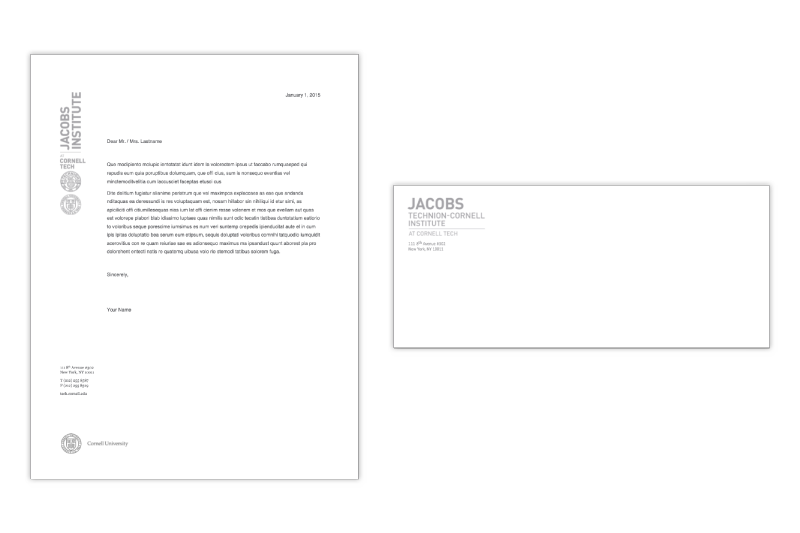
Email Signatures
The download for the email signature template includes instructions that contain essential link-sensitive information.
Cornell Tech

Jacobs Technion-Cornell Institute

Style Guide
On this page you will find highlights from the Cornell Tech Style Guide, including proper style and nomenclature for campus partners, affiliations and academic degrees. The full Style Guide includes additional guidelines specific to Cornell Tech as well as helpful information on common spelling, grammar, and punctuation questions. It is a guide for non-academic writing on campus.
Cornell Tech Style
Institutional Names
- Cornell Tech – never Cornell NYC Tech
- Joan & Irwin Jacobs Technion-Cornell Institute – proper name
- Jacobs Technion-Cornell Institute – preferred, as shorter
- Jacobs Institute – on 2nd reference
- Cornell University
- Weill Cornell Medicine
- Technion – Israel Institute of Technology
- the Technion – short version
Masters Programs
We refer to our masters programs differently depending on the context. Below you will find three different versions: Program Name, Degree Name and Short Form or how the program is referred to colloquially or on 2nd reference in written form. There should rarely be a need to use the full Degree Name.
Program — Master in Computer Science
Degree — Master of Engineering in Computer Science
Short Form — CS Masters
Program — Master in Electrical and Computer Engineering
Degree — Master of Engineering in Electrical and Computer Engineering
Short Form — ECE Masters
Program — Master in Operations Research and Information Engineering
Degree — Master of Engineering in Operations Research and Information Engineering
Short Form — ORIE Masters
Program — Technion-Cornell Dual Master’s Degrees in Connective Media
Degree — Technion Master of Science in Applied Information Sciences and Cornell Master of Science in Information Systems with Concentration in Connective Media
Short Form — Connective Media degree
Program —Technion-Cornell Dual Master’s Degrees in Health Tech
Degree —Technion Master of Science in Applied Information Sciences and Cornell Master of Science in Information Systems with Concentration in Health Tech
Short Form — Health Tech degree
Program — Johnson Cornell Tech MBA
Degree —Master of Business Administration
Short Form — MBA
Program —Master of Laws in Law, Technology and Entrepreneurship
Degree — Master of Laws in Law, Technology and Entrepreneurship
Short Form — LLM
Affiliations
Faculty at Cornell Tech are either affiliated with Cornell Tech or the Jacobs Institute. It is important that Jacobs faculty make the Jacobs affiliation clear when at all possible:
- For ex.: Joe Shmo, Professor, Jacobs Technion-Cornell Institute at Cornell Tech
Academic Degrees
Do not capitalize doctorate, doctor’s, bachelor’s, master’s degree, master of science, etc. in running text.
Abbreviate the degrees Master of Science, Master of Arts, Master of Engineering, and Doctor of Philosophy to M.S., M.A., M.Eng., Ph.D. Do not use periods for MBA.
Do not use periods in degree designations when referring to people or programs. When referring to the degree itself, use periods.*
- At Cornell Tech, the LLM candidates work in teams with students from other programs.
- Sarah Thompson received a B.S. from Caltech and a Ph.D. from Berkeley.
* WEB USAGE EXCEPTION: The Cornell Tech website & blog doesn’t use periods in any mention of Cornell Tech programs.
Capitalize the names and abbreviations of academic degrees, whether they follow personal names or stand by themselves:
- Jane Smith, Master of Science
- Tom Brown, M.S.
- His MBA is from the Johnson School.
- She recently received her Ph.D.
When used more generally, lowercase is preferred:
- Ms. Smith earned her master’s degree in information science.
Terminology
Cornell Tech-specific terms are described on this page, including Curricular Terms and Research and Development Initiatives. If there are terms that you believe should be added to this page, please submit them to Strategic Communications.
Curricular Terms
Company Challenges
Every fall semester at Cornell Tech, students in Product Studio respond to challenges posed by leading startups, companies, and organizations in NYC, and deliver new business ideas and prototypes by the end of the semester.
Conversations in the Studio
This practicum features a weekly guest practitioner for a provocative, closed-door discussion with students and are moderated each week by a randomly assigned group of students that come prepared with questions and discussion topics. This is not a lecture: it’s a weekly wake-up call.
Crit Advisors
Students participate in weekly crit sessions with external practitioners to drive momentum and receive validation, feedback, and critique. These practitioners are active founders and entrepreneurs, product managers, and technical managers in NYC that come to campus twice a semester to provide practical feedback and instruction, encourage progress, and help address any blockers or risks the students are facing. Crit Advisors come to campus twice/semester.
Open Studio
Open Studio is an important part of Cornell Tech’s reimagination of graduate tech education. Open Studio happens every semester where our students, faculty, Postdocs and the Foundry show off the work and products that they are building. Open to the public.
PM
Product management. AÂ product manager is often considered the CEO of their product and is responsible for the strategy, roadmap, and feature definition for that product or product line. The position may also include marketing, forecasting, and profit and loss (P&L) responsibilities.
Product Studio
Product Studio is fall practicum that all Cornell Tech masters students take. In the class, they tackle Company Challenges.
Scrum
Scrum is dedicated meeting time for students to practice and develop the muscle memory of building new products, receive and give feedback and validation, and address blockers and risks, all of which ultimately leads to learning how to create great products. Scrum is a safe place for students to fail (fast), help each other, and then analyze, adapt, and repeat.
Startup Award
Pre-seed funding awarded to student startup companies wanting to spin out and commercialize. The award is $100k ($80k of cash in 2 tranches and $20k of value for co-working space).
Startup Ideas
This practicum helps students develop their ability to imagine, recognize, develop, and improve startup ideas. By the end of the practicum, students self-organize into co-founding teams around specific startup ideas that they will execute on in Startup Studio the following semester.
Startup Projects
Original startup companies started by students during spring semester. Startup Projects are the output of Startup Studio.
Startup Studio
In the spring semester at Cornell Tech, students co-found their own startups, developing their ideas, products, and pitches, learning to create and tell a compelling startup story, and test their product with users. Startup Studio has many 3 main parts: a group lecture, student led scrums, and crit sessions with external practitioners. Lead by David Tisch.
Student Scrum Master
Our Scrum Masters, who lead scrum meetings, are a select group of students that apply for the role.
Studio
Open area on 3rd floor. Formerly “Commons.â€
Studio Sprint
Monthly 24-hour long work days dedicated to making advances on startup and company challenges (and student projects for MS in IS students not enrolled in Startup Studio or Product Studio).
Research and Development Initiatives
Connective Media Hub
A Jacobs Technion-Cornell Institute research domain, this hub focuses on the technology driving digital media, as well as the psychological, social and business forces at play in today’s connected media. Spans mining and analysis of structured and unstructured online sources; machine learning and big data; and mobile platforms.
An endeavor of the Jacobs Technion-Cornell Institute in collaboration with AOL, the Cx lab develops new technologies to revolutionize services and applications for connected environments using novel data sources, algorithms and interaction techniques. Led by Prof. Mor Naaman.
The Foundry @ Cornell Tech is an interdisciplinary team of experienced makers. Its mission is to (a) source problems, (b) connect people, (c) advise on projects, and (d) productize ideas and research.
The Foundry engages with the Cornell Tech community (faculty, students, postdoc, staff, etc.) to help them have a greater impact on academia and society at large.
Health Tech Hub
A Jacobs Technion-Cornell Institute research domain, this hub emphasizes individual healthcare technology to promote healthier living. Aims to create better healthcare information systems, mobile healthcare applications and medical devices for medical monitoring.
Cryptocurrencies and smart contracts are maturing into a rich spectrum of new financial instruments and business tools, and blending finance with computer science in unprecedented ways. IC3 aims to meet the cryptocurrency community’s growing need for scientific leadership in cryptography, programming languages, and distributed systems that will foster impactful innovations with rigorous foundations.
IC3 is an initiative of faculty members at Cornell University, Cornell Tech, and UC Berkeley based at the Jacobs Technion-Cornell Institute. Led Prof. Ari Juels.
The Runway Startup Postdoc Program is part business school, part research institution, and part startup incubator. Based at the Jacobs Technion-Cornell Institute, Runway ushers recent PhDs in digital technology fields through a paradigm shift—from an academic mindset to an entrepreneurial outlook.
Startup Postdocs arrive with ideas for unproven products and markets that require time and specialized guidance to develop. The program lasts 12–24 months and incorporates academic and business mentorship.
The Small Data Lab develops new personal data APIs and applications for individuals to harvest the small data traces they generate daily. Led by Prof. Deborah Estrin.
Design, build, and study systems that support social interactions in online and physical spaces. Led by Prof. Mor Naaman.
For a detailed overview of all Strategic Communications policies and procedures please see Working with Strategic Communications.
Please send any questions or feedback about this site to stratcomms@tech.cornell.edu.